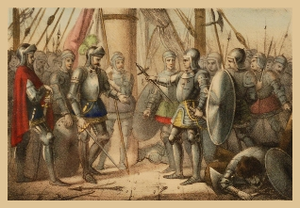Battle of Ponza (1435)
| Battle of Ponza | |||||||
|---|---|---|---|---|---|---|---|
| Part of Aragon's Conquest of Naples | |||||||
 The surrender of Alfonso V of Aragon | |||||||
| |||||||
| Belligerents | |||||||
|
[1][2][3][4][5] |
[6][2][3][5] | ||||||
| Commanders and leaders | |||||||
|
[1][2][5][8][9] |
King of Aragon (POW) King of Navarre (POW) Prince Infante (POW) [6][1][3][9][10] | ||||||
| Strength | |||||||
|
Genoese fleet: 3 galleys 13 vessels 2,400 soldiers [10][11][12] |
Aragonese fleet: 11 galleys 14 vessels 6,000 soldiers [10][11][12] | ||||||
| Casualties and losses | |||||||
| 90 killed[8] |
600 killed[8] ~ 100 Aragonese nobles captured [7][10] 13 vessels lost[1][2] | ||||||
The Naval battle of Ponza was fought in early August 1435, when the Duke of Milan dispatched a Genoese fleet, in order to relief the town of Gaeta,[13] which was currently being besieged by the King of Aragon.[14]
Conflict
Joan II, Queen of Naples, died on 2 February 1435,[7] and by her will bestowed Rene d'Anjou with the crown of Naples.[14] However, Alfonso, king of Aragon and Sicily, whom Queen Joan II had primarily adopted, claimed the succession, on the ground of this first adoption.[7] Thus the successionist war between the House of Anjou and the House of Aragon over the Kingdom of Naples ensued.[12][13]
At this critical moment Rene d'Anjou was currently imprisoned in the Duchy of Burgundy[15] and Alfonso of Aragon lost no time in stirring up his partisans in the Kingdom of Naples, whilst he himself sailed from Sicily with a large fleet to besiege Gaeta.[14]
Gaeta itself was garrisoned by the Genoese[2] who shortly after Queen Joan's death dispatched Francesco Spinola with 800 infantry.[3][16] The Duke of Milan (to whom the Republic of Genoa had lately submitted)[7] sided with the House of Anjou[16] and dispatched a Genoese fleet[13] in July under Biagio Assereto in order to relief Gaeta.[16] Alfonso immediately sailed against the Genoese fleet[12] with superior numbers.[15] The two fleets met near the island of Ponza and after a long and gallant conflict,[15] which lasted for ten hours,[13] the Genoese were completely victorious.[4] The royal galley of Aragon was compelled to strike,[15] and Alfonso V, King of Aragon was captured.[6]
Aftermath
The siege of Gaeta was lifted,[12] and the return of the Genoese fleet was met with a triumphant reception at Genoa.[10] The King and all the noble Aragonese prisoners were then brought to Milan before the Duke,[16] and with this one strike the war seemed already over.[9]
However the King of Aragon managed to persuade the Duke of Milan to his side and against Rene d'Anjou, and was set at liberty with all other prisoners.[7] The Genoese were so utterly exasperated by the Dukes decision[2] that they started to rebel against him, drove out the Milanese garrison and overthrew his rule on 27 December 1435.[7]
Sources
- ^ a b c d e Zurita, Jerónimo (1579). Segunda parte de los Anales de la Corona de Aragon: Book 14. Zaragoza.
- ^ a b c d e f g Burchett, Josiah (1720). A Complete History of the Most Remarkable Transactions at Sea. London.
- ^ a b c d e Ersch, Johann Samuel (1847). Allgemeine Encyclopädie der Wissenschaften und Künste: 3. Section. Leipzig.
- ^ a b c de Cherrier, Claude Joseph (1858). Histoire de la Lutte des Papes et des Empereurs: Vol.III. Paris.
{{cite book}}: CS1 maint: location missing publisher (link) - ^ a b c Schlosser, Friedrich Christoph (1849). F. C. Schlosser's Weltgeschichte für das Deutsche Volk: Vol.IX. Frankfurt a.M.
- ^ a b c d de Madrazo, Pedro (1839). Recuerdos y bellezas de España: Cataluña. Barcelona.
- ^ a b c d e f g Simonde de Sismondi, Jean-Charles-Léonard (1832). A History of the Italian Republics. Philadelphia.
- ^ a b c Canale, Michele Giuseppe (1864). Nuova Istoria della Repubblica di Genova: Vol.IV. Florence.
{{cite book}}: CS1 maint: location missing publisher (link) - ^ a b c Gregorovius, Ferdinand (1988). Geschichte der Stadt Rom im Mittelalter: Book 1-6. Munich.
{{cite book}}: CS1 maint: location missing publisher (link) - ^ a b c d e von Stramberg, Christian (1858). Denkwürdiger und nützlicher Rheinischer Antiquarius: Vol.VII. Koblenz.
{{cite book}}: CS1 maint: location missing publisher (link) - ^ a b Troyli, Placido (1753). Istoria generale del Reame di Napoli. Naples.
- ^ a b c d e Leo, Heinrich (1829). Geschichte von Italien: Vol.III. Hamburg.
- ^ a b c d von Meerheimb, Richard (1865). Von Palermo bis Gaëta. Dresden.
{{cite book}}: CS1 maint: location missing publisher (link) - ^ a b c Society for the Diffusion of Useful Knowledge (1843). The Biographical Dictionary: Vol.II. London.
- ^ a b c d Col. Proctor, George (1844). The History of Italy. London.
- ^ a b c d Ersch, Johann Samuel (1854). Allgemeine Encyclopädie der Wissenschaften und Künste: 1. Section. Leipzig.
{{cite book}}: CS1 maint: location missing publisher (link)
